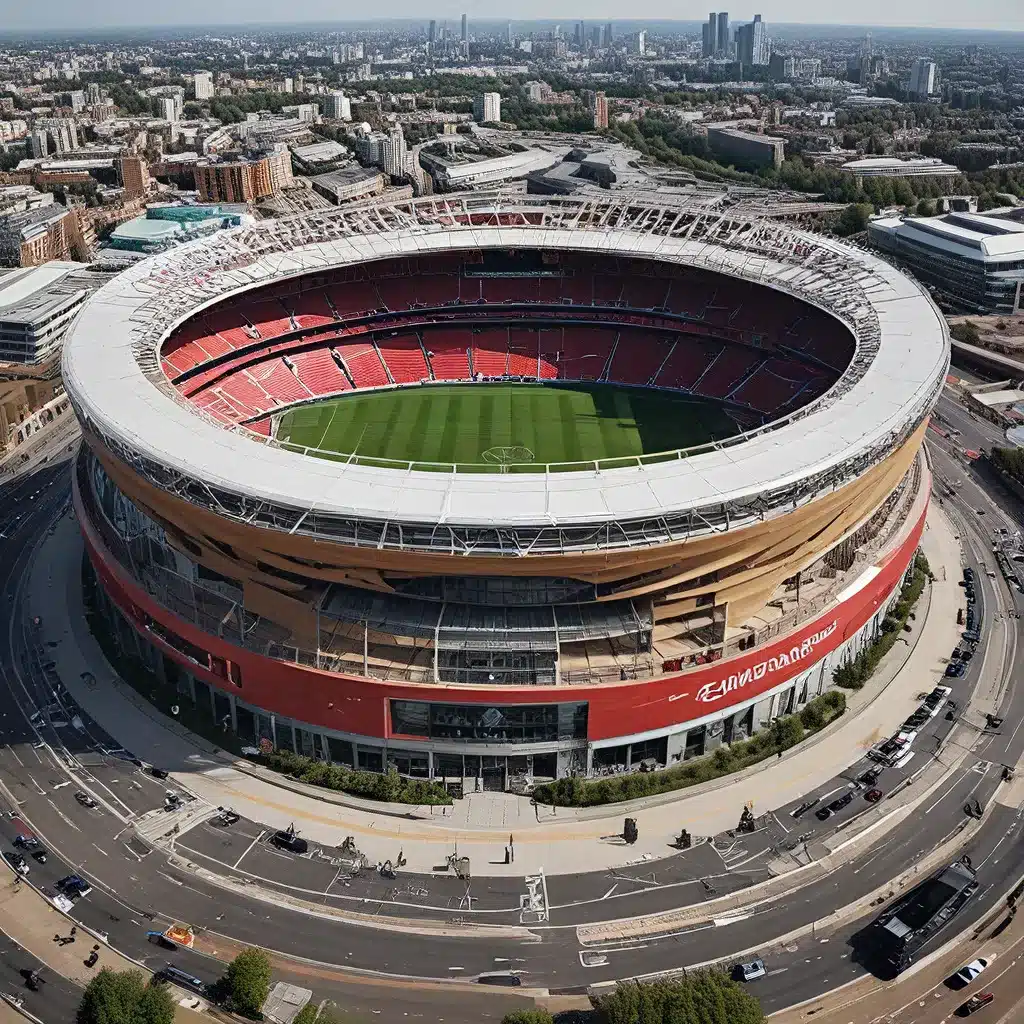
A Masterpiece of Modern Stadium Design
The Emirates Stadium, home to the renowned English Premier League club Arsenal, stands as a testament to the power of innovative design. Nestled in the heart of London, this architectural marvel has captivated sports enthusiasts and architecture aficionados alike since its inauguration in 2006.
Crafted by the renowned architectural firm HOK Sport (now known as Populous), the Emirates Stadium is a true engineering and aesthetic triumph. The stadium’s striking silhouette, characterized by its sweeping curves and sleek lines, has become an iconic landmark in the city’s skyline. But beyond its stunning exterior, the Emirates Stadium is a meticulously designed venue that prioritizes the experience of both players and fans.
Seamless Integration with the Urban Landscape
One of the Emirates Stadium’s most remarkable features is its seamless integration with the surrounding urban landscape. The architects carefully considered the stadium’s placement within the Ashburton Grove district, ensuring that it complemented the existing architecture and public spaces. The use of terracotta and glass in the stadium’s façade creates a harmonious visual dialogue with the nearby buildings, while the incorporation of public plazas and pedestrian walkways around the venue encourages a vibrant, community-centric atmosphere.
The stadium’s strategic location has also been a crucial factor in its success, providing easy access for fans and facilitating strong connections to the city’s public transportation network. The underground station and bus stops located adjacent to the stadium make it a convenient destination for visitors, further enhancing the overall experience.
Innovative Design and Engineering Feats
The Emirates Stadium’s design is a true marvel of engineering, with numerous innovative features that set it apart from traditional stadium designs. The stadium’s iconic curving roof, for instance, is a structural masterpiece, spanning an impressive 300 meters and providing ample coverage for the entire seating bowl.
The roof’s unique design also incorporates a series of retractable panels, allowing for natural ventilation and the regulation of the indoor climate. This innovative approach not only enhances the comfort of spectators but also reduces the stadium’s energy consumption, making it a more environmentally sustainable venue.
Furthermore, the Emirates Stadium’s seating bowl is designed to optimize the viewing experience for fans. The asymmetrical layout and steep incline of the stands ensure that every seat offers an unobstructed view of the pitch, while the generous leg room and comfortable seats contribute to the overall comfort of the spectators.
Enhancing the Matchday Experience
Beyond its architectural excellence, the Emirates Stadium is renowned for its commitment to enhancing the matchday experience for fans. The venue boasts a range of amenities and hospitality offerings that cater to the diverse needs of its supporters.
The premium hospitality lounges and executive boxes provide a luxurious and exclusive experience for those seeking a more elevated game-day experience. These spaces offer gourmet dining options, private bars, and dedicated concierge services, ensuring that VIP guests are treated to a truly exceptional experience.
For the general public, the stadium’s concourse areas are designed to be vibrant and engaging, with a variety of food and beverage outlets, souvenir shops, and interactive fan zones. The integration of digital technology, such as interactive screens and mobile applications, further enhances the fan experience, providing real-time match updates, statistics, and exclusive content.
A Sustainable and Environmentally Conscious Venue
The Emirates Stadium is not only a architectural masterpiece but also a sustainable and environmentally conscious venue. The stadium’s design incorporates a range of green initiatives, including the use of renewable energy sources, water conservation measures, and waste management systems.
The stadium’s ETFE (Ethylene Tetrafluoroethylene) roof, for instance, is a transparent, lightweight, and highly efficient material that allows for natural light to flood the interior, reducing the need for artificial lighting. Additionally, the rainwater harvesting system and the use of drought-resistant landscaping around the stadium contribute to its overall water efficiency.
These sustainable features not only reduce the stadium’s environmental impact but also demonstrate Arsenal’s commitment to being a responsible and forward-thinking organization. By prioritizing sustainability, the club sets an example for other sports venues and reinforces its position as a leader in the industry.
A Global Icon and a Source of Community Pride
The Emirates Stadium has firmly established itself as a global icon in the world of sports and architecture. Its stunning design, innovative features, and commitment to fan experience have earned it widespread acclaim, with the venue regularly hosting international football matches, concerts, and other high-profile events.
But the stadium’s significance extends beyond its status as a premier sporting venue. It has become a source of community pride for the people of Islington and the broader London area. The stadium’s role as a community hub, hosting a range of educational, cultural, and charitable initiatives, has cemented its position as an integral part of the local landscape.
The Emirates Stadium’s impact is felt far and wide, inspiring architects, engineers, and sports organizations around the world to strive for excellence in their own projects. As a testament to the power of innovative design and a deep understanding of the fan experience, the Emirates Stadium stands as a shining example of what a modern stadium can and should be.
Explore more captivating stadium stories on Old Stadium Journey.

